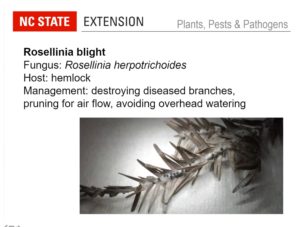Pest Alert – Rosellinia Blight on Hemlock
go.ncsu.edu/readext?749695
en Español / em Português
El inglés es el idioma de control de esta página. En la medida en que haya algún conflicto entre la traducción al inglés y la traducción, el inglés prevalece.
Al hacer clic en el enlace de traducción se activa un servicio de traducción gratuito para convertir la página al español. Al igual que con cualquier traducción por Internet, la conversión no es sensible al contexto y puede que no traduzca el texto en su significado original. NC State Extension no garantiza la exactitud del texto traducido. Por favor, tenga en cuenta que algunas aplicaciones y/o servicios pueden no funcionar como se espera cuando se traducen.
Português
Inglês é o idioma de controle desta página. Na medida que haja algum conflito entre o texto original em Inglês e a tradução, o Inglês prevalece.
Ao clicar no link de tradução, um serviço gratuito de tradução será ativado para converter a página para o Português. Como em qualquer tradução pela internet, a conversão não é sensivel ao contexto e pode não ocorrer a tradução para o significado orginal. O serviço de Extensão da Carolina do Norte (NC State Extension) não garante a exatidão do texto traduzido. Por favor, observe que algumas funções ou serviços podem não funcionar como esperado após a tradução.
English
English is the controlling language of this page. To the extent there is any conflict between the English text and the translation, English controls.
Clicking on the translation link activates a free translation service to convert the page to Spanish. As with any Internet translation, the conversion is not context-sensitive and may not translate the text to its original meaning. NC State Extension does not guarantee the accuracy of the translated text. Please note that some applications and/or services may not function as expected when translated.
Collapse ▲Once thought to be only in the western U. S., this fungus has is now present in North Carolina. It attacks conifers including hemlocks of all sizes and ages. It can kill small trees (seedlings, saplings, and young trees up to 15-20 feet tall), but it usually doesn’t kill larger trees except in hedges. Wet cool weather increases disease incidence. We have seen this in old hemlock hedges over the last three years.

Photo and slide info by Dr. Matt Bertone, NC State from his IPM update presentation
On larger trees the fungus affects the foliage on lower and inner branches, turning the needles a light brown and matting needles together at odd angles. You will see white fungal threads and black ball-shaped structures on the backside of leaves. The fungus becomes active in the spring and is made worse with cool weather and lots of rain. Damage usually doesn’t begin until early summer.
Thought to spread in the air, the fungus continues to spread and get worse through the summer until early fall when the temperature begins to cool and the humidity is lower. Observation has shown that once the disease is present in a tree, it is likely to continue breaking out each subsequent year unless the cycle is broken by fungicide treatments.




